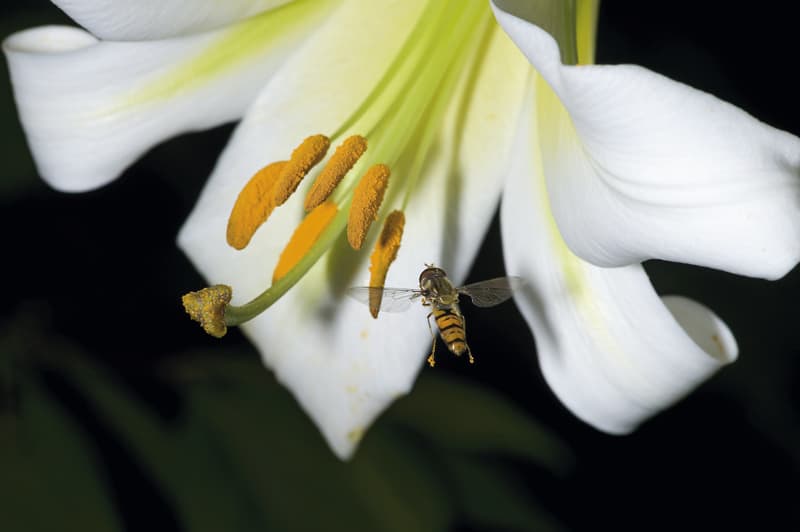Photo Insight with Heather Angel

An internationally renowned photographer of the natural world and author of more than 50 books, Heather brings her expertise to AP
I generally find that I’m able to get many of my most interesting shots when I’m not out looking for them. The image you see here was taken at the Royal Botanic Gardens, Kew, just before a workshop that I was due to conduct with a small group. I had arrived there early and found this gorgeous lily near the lab where I was working. I took a wander around and found it under a tree.
What caught my eye at first was not so much the insects that were flying around, but the fact that it was a species of lily I had previously photographed in China. The flower grows at between 500 and 2,000 metres (1,640-6,560ft), and when I originally saw it in China I was driving along the road and found it growing from a crevice in a large vertical rock. I just had to stop to photograph it. It was lovely finding it again at Kew and I decided to photograph it while I had a few spare moments.
When I got a little closer I began to notice these little hoverflies flitting around and feeding on the pollen (appropriately, hoverflies are also sometimes called flower flies). I had originally intended to shoot the flower by itself, but once I saw the hoverflies interacting with the flower I realised that, photographically, they would be a perfect fit to get a nice shot. It was interesting to see such a small insect being dwarfed by this huge flower while at the same time engaging in an act that was mutually beneficial and necessary for the wider environment. To me, this interdependence was as interesting as the insect and the flower, maybe more so.

I shot at 1/250sec at f/8 and used fill flash from a Nikon Speedlight SB-900, all on a Nikon D3 DSLR with Nikkor 105mm lens. I also used a Honl softbox, which is something I’ve mentioned before. Some Velcro strips are fitted around the edges of a flashgun and this miniature softbox is then attached to the end. It’s a really neat little device and so much better, I find, than the Sto-Fen diffusers that also attach to flashguns because the Honl gives a better spread of diffused light that almost has the appearance of natural light. The last thing that anyone wants is for someone to look at images of flowers and insects and know right away that they were taken with flash. My thinking is that flash is there to give images an appearance of naturalism. There’s nothing worse than seeing an otherwise good shot that has been ruined by the poor application of flash. When it becomes obvious that flash was used, the illusion and spell of the image are broken.
When I first started taking pictures of this lily at Kew, the hoverflies were coming and going, and feeding on the flower’s nectar and pollen. The thing that particularly grabbed my interest was that one of the hoverflies had pollen stuck to its feet. To feed on the pollen the hoverflies must stand on the male part of the flower, called the stamen. These stamens produce large amounts of pollen, the grains of which are rather big in comparison to the small body of the hoverfly. As conditions can be a bit sticky, the hoverfly ends up flying around with pollen stuck to its legs. The fly then moves to another flower with all this pollen and lands on that flower’s pistil (the female part) or, more specifically, the end, which is called a stigma. That’s the basic process of cross-pollination, although it can also occur when pollen is carried on the wind.
Pollination is a vital process within our environment and readers can do a lot to assist it by ensuring they have a wide variety of flowers and foliage within their own gardens. It provides the perfect environment for pollinators such as hoverflies and bees, and also gives photographers an excellent place to study the wonderful colours and shapes that can be found in the natural world. Your own back garden is one of the most vibrant environments for photography, and despite being a small contained area it can take a long time to fully explore.
Heather Angel was talking to Oliver Atwell

To see more images by Heather visit www.heatherangel.co.uk or www.naturalvisions.co.uk. Heather regularly runs workshops at the British Wildlife Centre. For information on courses run by Heather and her son Giles, visit www.photographyandphotoshopcourses.co.uk








